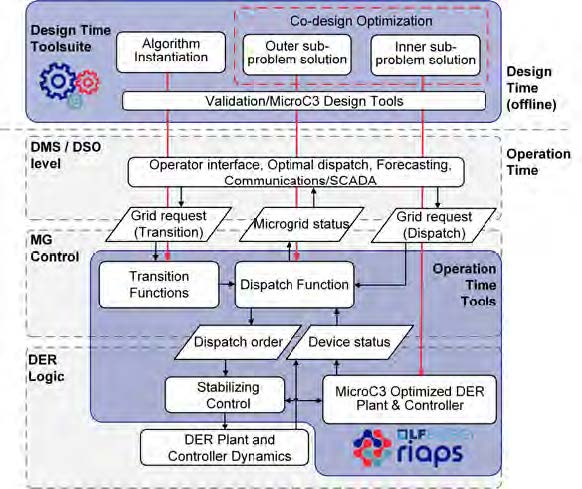Microgrid Control/Coordination Co-Design (MicroC3)
 Today’s microgrids are one-off configurations of commercially available equipment and some custom software that implements some microgrid control functions, as well as integrates the components. They are rarely optimized for the specific microgrid architecture, equipment, physical or economic environment, and they are often proprietary, closed systems, leading to vendor-lockin, and brittle, unmodifiable implementations. The microgrid control algorithms are typically designed and implemented
Today’s microgrids are one-off configurations of commercially available equipment and some custom software that implements some microgrid control functions, as well as integrates the components. They are rarely optimized for the specific microgrid architecture, equipment, physical or economic environment, and they are often proprietary, closed systems, leading to vendor-lockin, and brittle, unmodifiable implementations. The microgrid control algorithms are typically designed and implemented
only after the equipment has been selected, leading to sub-optimal performance, and often cost overruns during implementation. Clearly, a better approach is needed for both the design and the operation of (the system of) microgrids.
The project's vision is to radically change this paradigm in two ways: (1) Acknowledge that control is critical for the dependable and economical operation of microgrids and develop, implement and demonstrate a structured ‘microgrid control/coordination co-design flow’ that yields not only the selection of right-sized equipment but a concrete, integrated control and communication software/hardware architecture with its implementation validated in a simulation environment, (2) Recognize the importance and cost of system integration and develop, implement, and demonstrate a ‘modular resilient microgrid control integration platform’: a hardware device with a robust, cyber-secure software platform and a library of microgrid control algorithms that can be automatically customized by the microgrid control/coordination co-design flow.
The project is in collaboration with North Carolina State University as the lead institution.
Microgrids deliver highly resilient power supply to local loads in the event of a power outage while also improving distribution system reliability by reducing the system’s load under stress conditions. Microgrids also integrate and manage renewable generation on the distribution system. Today’s microgrids are one-off configurations of commercially available equipment and custom software that implements microgrid control functions and integrates the components. They are rarely optimized for the specific microgrid architecture, equipment, physical or economic environment, and are often proprietary, closed systems, leading to vendor-lock-in and unmodifiable implementations.
This project will radically change how future microgrids are designed by developing a suite of microgrid control/coordination co-design tools capable of performing systematic design of an optimized microgrid, given a set of design objectives and performance constraints. The team develops a well-documented co-design engineering process supported by a tool suite that yields optimal equipment selection, guarantees system stability, evaluates system dynamics, and delivers an integrated coordination/control and communication software/hardware architecture with a concrete implementation validated in high-fidelity simulations. The team will also deliver an open-source microgrid control integration platform: a hardware device with sensing, actuation capabilities and networked, embedded software that can realize the outputs of the design flow in a concrete, physical form. Such automated implementation of control and communication architecture into the operational environment is expected to significantly reduce the cost of microgrid deployment.
The project's process of addressing the control, communication and coordination aspects of the design early in the design phase enabled by a tool suite-supported design flow makes microgrid engineering more affordable and allows more optimal, functional, and resilient designs. The team’s design and operational approach will advance the state-of-the-art for microgrids with respect to:
- Security: Provide power to critical loads during and after extreme weather events, when the rest of the grid may be damaged.
- Environmental: Integrate and effectively manage renewable generation on the distribution system.
- Economy: Predict and achieve or exceed the desired microgrid performance and reliability metrics with significantly smaller and/or simpler and less expensive components.